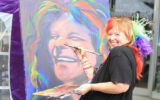Chances are you’ve known a writer who you appreciate, a writer who, if you could, you’d like to ask about their writing. Fortunately, I have a friend who is a published poet, a fine writer who teaches doctoral students in creative writing at the Union Institute and University. For too brief a time, Dr. Carol Barrett was my mentor.
What follows are my questions and her answers.
Barry Koplen: When did you know you wanted to be or happened to be a writer?
Dr. Carol Barrett: I was in my early thirties, looking for a way to encourage widowed women in their grief, and went to see a writer on the campus where I was teaching in Kansas to see if she would work with me on an anthology of poetry.
BK: Was there a story you wanted to tell?
CB: My first public reading was at the funeral for my grandmother, who lived to be 100 years and eight days. She knew about goals!
BK: Did anyone inspire you to be a writer?
CB: My first mentor introduced me to many contemporary poets; each one influenced me as I tried to emulate their work.
BK: When did you know whether you wanted to write prose or poetry?
CB: I fell in love with poetry; only later did I realize that, if I wrote true stories, they could be considered creative nonfiction, even if they began as poems.
BK: Were you inspired by another writer, perhaps a famous writer?
CB: Poet Anita Skeen mentored me for three years.
BK: Did you take classes or did someone train you?
CB: I took a class with Anita Skeen, and she continued to read and comment on my work.
BK: Once you began to write, what were some of the difficulties you had to overcome?
CB: Having a sharp pencil handy was a constant challenge. I didn’t want to write in ink; it was too permanent. As I wrote about family members, I learned to disguise their relationship in the poetry when it seemed appropriate to protect their identity. But most poems honored the relationship. I once wrote a poem in which I killed my father off, then shared it with him, decades before he died. I knew how important he was to me and figured I had better get used to not having him around.
BK: Which famous writers are your favorites?
CB: Mary Oliver is my all-time favorite.
BK: Have you published any of your writing? If so, please provide the titles and a brief description. If they are still in print, where can they be purchased?
CB: Yes – about 300 poems, including work in over fifty anthologies, and three books: Calling in the Bones, Drawing Lessons, and Pansies. They can be purchased from me directly through an email inquiry (carol.barrett@myunion.edu) or through Amazon, or one of the presses – Ashland Poetry Press in Ohio, Finishing Line Press in Kentucky, and Sonder Press in New York. Calling in the Bones is a collection of poems about the human family – all of us, including the particular one I was blessed with. Drawing Lessons is about drawing things, which come to take on metaphoric significance. Pansies is a book about the Apostolic Lutheran community, who forbid birth control. I hired a young woman as a babysitter for my toddler and was privileged to get to know the group in a way few people do. She was terrific.
BK: Finally, do you have any advice for writers who are just getting started?
CB: Have fun with your writing. Play with it. Save every draft. It’s precious work, even if it doesn’t go anywhere public.






